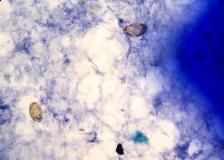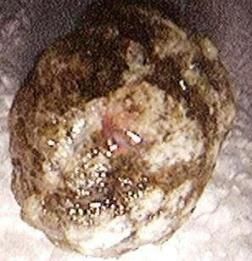Liver Fluke Infection in a Russian Immigrant

A 40-year-old Russian immigrant presented with a 2-week history of right upper quadrant abdominal pain, pruritus, chills, fever, and jaundice. Her past medical history, family history, social history, and review of systems were unremarkable. Before immigrating to the United States 10 years before this hospitalization, she frequently ate freshwater sushi.
Other than a low-grade fever (temperature, 38ºC [100.8ºF]), the patient’s vital signs were normal. Physical examination revealed tenderness in the right upper quadrant of her abdomen. Murphy's sign was negative.
Figure 1.

Initial laboratory test values were as follows: conjugated hyperbilirubinemia (total bilirubin, 2.8 mg/dL [normal, 0.2-1.3 mg/dL]; direct bilirubin, 2.5 mg/dL [0.0-0.3 mg/dL]); AST 87 U/L (17-59 U/L); ALT 222 U/L (21-72 U/L); alkaline phosphatase, 156 U/L (38-126 U/L). On admission, levels of electrolytes, BUN, creatinine, amylase, and lipase were normal. The white blood cell count was normal, with 6% eosinophilia. Abdominal ultrasonography showed biliary dilatation of the common hepatic duct to 1.4 cm and a normal size caliber common bile duct (CBD) at 5 mm.
Figure 2.

Endoscopic retrograde cholangiogram (ERCP) revealed a CBD obstruction with upstream biliary dilation, suggestive of an impacted gallstone (Figure 1). Sphincterotomy was performed and a biliary stent was placed for decompression. Analysis of the collected bile revealed parasitic organisms (multiple ova [Opisthorchis felineus]) (Figure 2), and a ventral sucker of an adult liver fluke (Figure 3).
The patient was treated with antibiotics (ciprofloxacin and metronidazole) and oral praziquantel. A repeated ERCP (performed 2
Figure 3.
months later) revealed persistent biliary dilatation, resolution of the previously noted biliary stricture, and a freely floating choledochal filling defect. A disimpacted 9-mm CBD stone was extracted (Figure 4). She was subsequently referred for laparoscopic cholecystectomy and her postoperative hospital course was uneventful.

Discussion
While rare in the United States, parasitic infections of the human biliary tract are endemic in many parts of the world, including Eastern Asia, Africa, Latin America, Eastern Europe, and the former Soviet Union.1 Because of the rising number of international travelers and of immigrants to the United States, cases of symptomatic fluke infections continue to be occasionally encountered. Infections are typically acquired by eating raw or undercooked fish (often found in sushi).2 Fluke infection is often under-diagnosed because of general lack of awareness of the entity among clinicians in the US. It is important to differentiate this disease from other, more common diseases that can present similarly.
Figure 4.
The disease manifestations of the fluke are primarily limited to the biliary tract. Acute infection may be asymptomatic; heavy exposures can lead to high-grade fever, nausea, vomiting, abdominal pain, malaise, arthralgia, hepatic tenderness, lymphadenopathy, and rash.1,3,4 Common laboratory findings include peripheral eosinophilia, hyperbilirubinemia, and elevated liver enzyme levels. Chronic infections can result in hepatomegaly, malabsorption, malnutrition, recurrent cholangitis, and liver abscess. The biliary metacercaria and eggs produce intense inflammation, periductal fibrosis, and epithelial hyperplasia and can result in biliary stone formation (oriental hepatitis), biliary strictures, and possibly cholangiocarcinoma.5
Opisthorchiasis is mainly diagnosed by detection of eggs in the feces (Kato-Katz method). In light infections (fewer than 10 adult flukes in the biliary tract) or in infections with biliary obstruction, eggs may not be detected in stool.2 The most common finding on ultrasonography is intrahepatic ductal dilation (in 76% of patients).5
ERCP with biliary decompression followed by a sample bile aspiration for microscopic analysis can often secure the diagnosis.6 New serologic diagnostic tests are being developed with high sensitivity and specificity using a recombinant eggshell protein.2
The recommended treatment for opisthorchiasis is praziquantel 25 mg/kg every 8 hours for 3 doses.
References
1. Lim JH, Kim SY, Park C. Parasitic diseases of the biliary tract. Am J Roentgenol. 2007;188:1596-1603.
2. Marcos LA, Terashima A, Gotuzzo E. Update on hepatobiliary flukes: fascioliasis, opisthorchiasis and clonorchiasis. Curr Opin Infect Dis. 2008;21:523-530.
3. Watanapa P, Watanapa WB. Liver fluke-associated cholangiocarcinoma. Br J Surg. 2002;89:962-970.
4. Tselepatiotis E, Mantadakis E, Papoulis S, et al. A case of Opisthorchis felineus infestation in a pilot from Greece. Infection. 2003;6:430-432.
5. Choi MS, Choi D, Choi MH, et al. Correlation between sonographic findings and infection intensity in clonorchiasis. Am J Trop Med Hyg. 2005;73:1139-1144.
6. Choi TK, Wong KP, Wong J. Cholangiographic appearance in clonorchiasis. Br J Radiol. 1984;57:681-684.